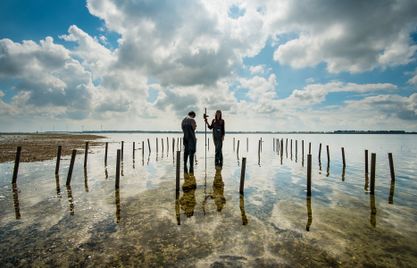PR 00299: verschil tussen versies
Geen bewerkingssamenvatting |
Geen bewerkingssamenvatting |
||
| Regel 14: | Regel 14: | ||
'''Contact:''' {{External link|resource=Resource Hyperlink 00709|name=Wietse van de Lageweg|dialog=process-linkwebsite-dialog}} | '''Contact:''' {{External link|resource=Resource Hyperlink 00709|name=Wietse van de Lageweg|dialog=process-linkwebsite-dialog}} | ||
{{Project config}} | {{Project config}} | ||
{{Project | {{Project | ||
|Name=Meerwaarde met Mosselen | |Name=Meerwaarde met Mosselen | ||
|Supercontext=Building with Nature | |Supercontext=Building with Nature | ||
|Start date= | |Start date=2015/01/01 | ||
|End date= | |End date=2020/12/31 | ||
|Summary=Musselbanks that stick out of the water during low tide have shown to be a positive addition to the environment. Sadly these structures have decreased or even disappeared over time. Bringing them back would be an improvement for coastal defense (it decreases the erosion in an area), natural value (birds, crabs and other wildlife are often found in these areas with a high food availability) and economy (mussel farmers could use a portion of the plots for cultivating and selling mussels). 'Added value with Mussels' looks at the best strategy to bringing back these types of musselbanks. | |Summary=Musselbanks that stick out of the water during low tide have shown to be a positive addition to the environment. Sadly these structures have decreased or even disappeared over time. Bringing them back would be an improvement for coastal defense (it decreases the erosion in an area), natural value (birds, crabs and other wildlife are often found in these areas with a high food availability) and economy (mussel farmers could use a portion of the plots for cultivating and selling mussels). 'Added value with Mussels' looks at the best strategy to bringing back these types of musselbanks. | ||
Versie van 30 mrt 2020 12:15
Littoral musselbeds form a very positive addition to intertidal areas. However, due to overfishing, introduced, competing species and climate change these structures have dissapeared within the Eastern Scheldt. Reintroducing littoral musselbeds would give a couple valuable additions to the current landscape. But what is the most effective and efficient way of reintroduction? The 'Added value with Mussels' project looks into different strategies to find out what works best and what the effects of the musselbeds are. The goals of the project are:
- Create new, viable production locations for shellfish cultivation
- Create (alternative) methods that help stabilizing or maybe even decrease erosion rates in intertidal areas
- Adding natural value to intertidal areas to comply with the new Natura-2000 goals set by the Dutch government
The results will be gathered by performing large-scale field experiments in the Eastern Scheldt. Different methods will be tested and the results will be compared to find the most effective way of reintroducing littoral musselbeds.
Research type: field research, desk analysis, lab research
Location: Easternscheldt, Viane, Zealand
Contact: Wietse van de Lageweg

